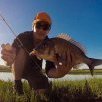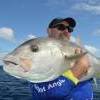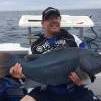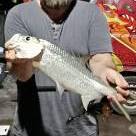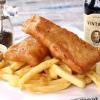
MAH
-
Content Count
193 -
Joined
-
Last visited
-
Days Won
44
Reputation Activity
-
 MAH got a reaction from Des in You Can Teach an Old Dog New Tricks
MAH got a reaction from Des in You Can Teach an Old Dog New Tricks
When bait fishing for tommies, it was simple. A size 10 long shank hook under a float with some split shot or a 1gm ball sinker. The thinking was tommies are a small fish so a small hook.
But with soft plastics I had no idea what to use, so tried different rigs to see what works best for me, I wanted to be able to quickly test different things like weights, hook sizes, lure sizes and lure quality. I bought a wide range of tackle and lures, so I would have them on hand during a fishing session and could readily make changes. I understand not everyone can afford to have lots of tackle on hand, and I did try and keep the costs down by buying from places like Aliexpress and the Japan Lure Shop.
To be able to quickly swap out tackle I use Mustad Fastattach Clips.
One of the first things I had trouble getting my head around was hook size for lure fishing, they all seemed so big. But I soon learned that a tommy has no trouble swallowing a 1/0 hook. I still keep a range of hooks with me because sometimes they will get fired up by the larger lure, but sometimes a smaller lure.
I also discovered that you can get hooks with bigger eyes, which make it easier to rig and also allows the hook more freedom of movement which should translate to more action from the lure.
-
 MAH got a reaction from Des in You Can Teach an Old Dog New Tricks
MAH got a reaction from Des in You Can Teach an Old Dog New Tricks
With lures I now buy only from Aliexpress. They are much cheaper and even the cheapest lures are durable enough if rigged correctly.
My go to lures are the cheapest. They have cost be about $1.80 for a pack of 10.
These are not very stretchy. Because a jig head holds them firmly in place and they lack stretch they will last only a couple of casts before a tommy rips the tail off. But if rigged on a worm hook and a Carolina rig, I can catch a dozen tommies before losing a lure and when they cost less than 20c per lure you can afford to lose a few. I also find them easier to rig on a hook than Zman lures, but you can't take them off the hook multiple times like Zman if you make a mistake rigging them. I like to rig up several before a session and keep them in a lure box ready to go.
The other Alixpress cheapies are very much like Zman lures and use the same plastic, so have the same stretchy durable qualities. I just ordered three packs of 6 lures and they cost $12.50. They come in good quality packaging.
-
 MAH got a reaction from Des in You Can Teach an Old Dog New Tricks
MAH got a reaction from Des in You Can Teach an Old Dog New Tricks
I also wasn't sure about what size weight to use. I read a lot of people recommending to use very small weights. I bought a range of styles of weights in 2gm, 3.5gm and 5gm. I found the cheb style of weight very versatile and easy to change, but now use the bullet weight a lot more as I'm using a Carolina rig mostly. I found the 2gm weights were not very useful and were too effected by wind and current. Now I mainly use 3.5gm, but on windy days I use a 5gm weight, mainly because fishing from a jetty, the wind easily catches your line and you need the extra weight to keep a tight line on the retrieve, otherwise the wind will just put a big bow in your line.
-
 MAH got a reaction from Des in You Can Teach an Old Dog New Tricks
MAH got a reaction from Des in You Can Teach an Old Dog New Tricks
I'm pretty sure Zman are a Thermoplastic Rubber (TPR), so when searching Aliexpress I look for soft plastic lure that mention TPR in the title.
The lures in my photos are from Johncoo on Aliexpress.
https://www.aliexpress.com/item/1005002526092840.html?spm=a2g0o.order_detail.order_detail_item.5.10b9f19c5V5d6w
https://www.aliexpress.com/item/1005002537821598.html?spm=a2g0o.order_detail.order_detail_item.3.10b9f19c5V5d6w
-
 MAH got a reaction from bjorn2fish in You Can Teach an Old Dog New Tricks
MAH got a reaction from bjorn2fish in You Can Teach an Old Dog New Tricks
With lures I now buy only from Aliexpress. They are much cheaper and even the cheapest lures are durable enough if rigged correctly.
My go to lures are the cheapest. They have cost be about $1.80 for a pack of 10.
These are not very stretchy. Because a jig head holds them firmly in place and they lack stretch they will last only a couple of casts before a tommy rips the tail off. But if rigged on a worm hook and a Carolina rig, I can catch a dozen tommies before losing a lure and when they cost less than 20c per lure you can afford to lose a few. I also find them easier to rig on a hook than Zman lures, but you can't take them off the hook multiple times like Zman if you make a mistake rigging them. I like to rig up several before a session and keep them in a lure box ready to go.
The other Alixpress cheapies are very much like Zman lures and use the same plastic, so have the same stretchy durable qualities. I just ordered three packs of 6 lures and they cost $12.50. They come in good quality packaging.
-
 MAH got a reaction from yellow door 1 in You Can Teach an Old Dog New Tricks
MAH got a reaction from yellow door 1 in You Can Teach an Old Dog New Tricks
When bait fishing for tommies, it was simple. A size 10 long shank hook under a float with some split shot or a 1gm ball sinker. The thinking was tommies are a small fish so a small hook.
But with soft plastics I had no idea what to use, so tried different rigs to see what works best for me, I wanted to be able to quickly test different things like weights, hook sizes, lure sizes and lure quality. I bought a wide range of tackle and lures, so I would have them on hand during a fishing session and could readily make changes. I understand not everyone can afford to have lots of tackle on hand, and I did try and keep the costs down by buying from places like Aliexpress and the Japan Lure Shop.
To be able to quickly swap out tackle I use Mustad Fastattach Clips.
One of the first things I had trouble getting my head around was hook size for lure fishing, they all seemed so big. But I soon learned that a tommy has no trouble swallowing a 1/0 hook. I still keep a range of hooks with me because sometimes they will get fired up by the larger lure, but sometimes a smaller lure.
I also discovered that you can get hooks with bigger eyes, which make it easier to rig and also allows the hook more freedom of movement which should translate to more action from the lure.
-
 MAH got a reaction from Plectropomus in You Can Teach an Old Dog New Tricks
MAH got a reaction from Plectropomus in You Can Teach an Old Dog New Tricks
I've been fishing for over 40 years, so grew up with fibreglass rods, monofilament and bait.
Now I have rod rack full of carbon fibre rods, it took me a bit longer to switch over to braid, but up until recently I was still a bait fisho and just didn't use soft plastics or other lures (except squid jigs). I bought plenty, vibes, hard bodies, soft plastics, and would give them a try but next session I would be back to bait.
But this summer I have taken the time to focus on soft plastics. Sure I still pump nippers for YFW and use gents for garfish, but I've spent most of my time learning to use soft plastics.
My target species for learning more about soft plastics has been the humble tommy ruff and 90% of the time I've targeted them off Glenelg jetty. I think a common species of a local jetty has been a very useful way to learn and is basically full circle back to when I was a kid fishing for tommies off Pt Vincent wharf.
Tommies are an interesting fish on soft plastics. They are fairly abundant and readily take a soft plastic, but when hooked, they go nuts with rapid head shakes and early on I was dropping many fish. First thing I changed was my rod. I was using a Daiwa Crosscast Rockfishing rod, it's a light rod with a fast action, rated for 3-10gm lures. at 7'8" it was a good rod for casting distance, the fast action was good for the initial strike, but it was too fast, too stiff for tommies as it lacked the suppleness to have enough bend to keep the pressure on and soak up the head shakes. Luckily I had the ideal rod in the rack and started to use an Atomic Arrowz Bream Surface. This rod had an immediate impact on my success rate landing fish. I pair this with a 1000 Stradic Ci4+.
Probably the biggest impact has been trying different ways to rig soft plastics. I started out using the standard jig heads most people use. There are plenty of people who use these jig heads with success, but I'm not one of them. So I started to use the American style offset worm hooks, setup like a cheb rig.
This was an improvement, but I still was dropping more fish than I was happy with. Like a jig head, the cheb rig has the weight right at the front of the soft plastic and my gut feel was the tommies used the weight and violent head shakes to throw the hook. Next change was to use a running rig setup, or what the Americans refer to as a Carolina rig.
Since changing to this rig, I rarely drop a fish.
Apart from sussing out the right rod and rig, I've settled on S-Factor for scent. I tried Pro-Cure, but it's always out-fished by the S-Factor.
For soft plastics, I most commonly use paddle tail style, but also have success with curly tail grubs. I've tried name brand lures like Zman Slim Swimz and no name cheapies off Aliexpress.
Zman are certainly durable and if using the cheapies on a jighead they get destroyed quickly, however I've found the cheapies are pretty good on an offset worm hook, A jig head holds the lure very firmly and the lack of give means the cheapies have the tail easily ripped off, as opposed to the super stretchy Zman. But on the worm hook, the cheapies are not held on as firmly a get pull down the hook rather than tearing up and last much longer. I vary the size of the cheapies, sometimes using a 5mm and sometimes a 7.5mm, and change depending on what is firing up the fish. As a general rule I find the bigger tommies hit the bigger lures more readily.
It took me a while to get the hang of soft plastics, but now this old dog readily get a feed.
I look at the weather, and if fine, just grab a rod, reel and a few soft plastics; very minimalistic, but a great way to fish and I don't know why I didn't try earlier.
-
 MAH got a reaction from Yorky in You Can Teach an Old Dog New Tricks
MAH got a reaction from Yorky in You Can Teach an Old Dog New Tricks
I've been fishing for over 40 years, so grew up with fibreglass rods, monofilament and bait.
Now I have rod rack full of carbon fibre rods, it took me a bit longer to switch over to braid, but up until recently I was still a bait fisho and just didn't use soft plastics or other lures (except squid jigs). I bought plenty, vibes, hard bodies, soft plastics, and would give them a try but next session I would be back to bait.
But this summer I have taken the time to focus on soft plastics. Sure I still pump nippers for YFW and use gents for garfish, but I've spent most of my time learning to use soft plastics.
My target species for learning more about soft plastics has been the humble tommy ruff and 90% of the time I've targeted them off Glenelg jetty. I think a common species of a local jetty has been a very useful way to learn and is basically full circle back to when I was a kid fishing for tommies off Pt Vincent wharf.
Tommies are an interesting fish on soft plastics. They are fairly abundant and readily take a soft plastic, but when hooked, they go nuts with rapid head shakes and early on I was dropping many fish. First thing I changed was my rod. I was using a Daiwa Crosscast Rockfishing rod, it's a light rod with a fast action, rated for 3-10gm lures. at 7'8" it was a good rod for casting distance, the fast action was good for the initial strike, but it was too fast, too stiff for tommies as it lacked the suppleness to have enough bend to keep the pressure on and soak up the head shakes. Luckily I had the ideal rod in the rack and started to use an Atomic Arrowz Bream Surface. This rod had an immediate impact on my success rate landing fish. I pair this with a 1000 Stradic Ci4+.
Probably the biggest impact has been trying different ways to rig soft plastics. I started out using the standard jig heads most people use. There are plenty of people who use these jig heads with success, but I'm not one of them. So I started to use the American style offset worm hooks, setup like a cheb rig.
This was an improvement, but I still was dropping more fish than I was happy with. Like a jig head, the cheb rig has the weight right at the front of the soft plastic and my gut feel was the tommies used the weight and violent head shakes to throw the hook. Next change was to use a running rig setup, or what the Americans refer to as a Carolina rig.
Since changing to this rig, I rarely drop a fish.
Apart from sussing out the right rod and rig, I've settled on S-Factor for scent. I tried Pro-Cure, but it's always out-fished by the S-Factor.
For soft plastics, I most commonly use paddle tail style, but also have success with curly tail grubs. I've tried name brand lures like Zman Slim Swimz and no name cheapies off Aliexpress.
Zman are certainly durable and if using the cheapies on a jighead they get destroyed quickly, however I've found the cheapies are pretty good on an offset worm hook, A jig head holds the lure very firmly and the lack of give means the cheapies have the tail easily ripped off, as opposed to the super stretchy Zman. But on the worm hook, the cheapies are not held on as firmly a get pull down the hook rather than tearing up and last much longer. I vary the size of the cheapies, sometimes using a 5mm and sometimes a 7.5mm, and change depending on what is firing up the fish. As a general rule I find the bigger tommies hit the bigger lures more readily.
It took me a while to get the hang of soft plastics, but now this old dog readily get a feed.
I look at the weather, and if fine, just grab a rod, reel and a few soft plastics; very minimalistic, but a great way to fish and I don't know why I didn't try earlier.
-
 MAH got a reaction from imfishn in You Can Teach an Old Dog New Tricks
MAH got a reaction from imfishn in You Can Teach an Old Dog New Tricks
I've been fishing for over 40 years, so grew up with fibreglass rods, monofilament and bait.
Now I have rod rack full of carbon fibre rods, it took me a bit longer to switch over to braid, but up until recently I was still a bait fisho and just didn't use soft plastics or other lures (except squid jigs). I bought plenty, vibes, hard bodies, soft plastics, and would give them a try but next session I would be back to bait.
But this summer I have taken the time to focus on soft plastics. Sure I still pump nippers for YFW and use gents for garfish, but I've spent most of my time learning to use soft plastics.
My target species for learning more about soft plastics has been the humble tommy ruff and 90% of the time I've targeted them off Glenelg jetty. I think a common species of a local jetty has been a very useful way to learn and is basically full circle back to when I was a kid fishing for tommies off Pt Vincent wharf.
Tommies are an interesting fish on soft plastics. They are fairly abundant and readily take a soft plastic, but when hooked, they go nuts with rapid head shakes and early on I was dropping many fish. First thing I changed was my rod. I was using a Daiwa Crosscast Rockfishing rod, it's a light rod with a fast action, rated for 3-10gm lures. at 7'8" it was a good rod for casting distance, the fast action was good for the initial strike, but it was too fast, too stiff for tommies as it lacked the suppleness to have enough bend to keep the pressure on and soak up the head shakes. Luckily I had the ideal rod in the rack and started to use an Atomic Arrowz Bream Surface. This rod had an immediate impact on my success rate landing fish. I pair this with a 1000 Stradic Ci4+.
Probably the biggest impact has been trying different ways to rig soft plastics. I started out using the standard jig heads most people use. There are plenty of people who use these jig heads with success, but I'm not one of them. So I started to use the American style offset worm hooks, setup like a cheb rig.
This was an improvement, but I still was dropping more fish than I was happy with. Like a jig head, the cheb rig has the weight right at the front of the soft plastic and my gut feel was the tommies used the weight and violent head shakes to throw the hook. Next change was to use a running rig setup, or what the Americans refer to as a Carolina rig.
Since changing to this rig, I rarely drop a fish.
Apart from sussing out the right rod and rig, I've settled on S-Factor for scent. I tried Pro-Cure, but it's always out-fished by the S-Factor.
For soft plastics, I most commonly use paddle tail style, but also have success with curly tail grubs. I've tried name brand lures like Zman Slim Swimz and no name cheapies off Aliexpress.
Zman are certainly durable and if using the cheapies on a jighead they get destroyed quickly, however I've found the cheapies are pretty good on an offset worm hook, A jig head holds the lure very firmly and the lack of give means the cheapies have the tail easily ripped off, as opposed to the super stretchy Zman. But on the worm hook, the cheapies are not held on as firmly a get pull down the hook rather than tearing up and last much longer. I vary the size of the cheapies, sometimes using a 5mm and sometimes a 7.5mm, and change depending on what is firing up the fish. As a general rule I find the bigger tommies hit the bigger lures more readily.
It took me a while to get the hang of soft plastics, but now this old dog readily get a feed.
I look at the weather, and if fine, just grab a rod, reel and a few soft plastics; very minimalistic, but a great way to fish and I don't know why I didn't try earlier.
-
 MAH got a reaction from bjorn2fish in You Can Teach an Old Dog New Tricks
MAH got a reaction from bjorn2fish in You Can Teach an Old Dog New Tricks
I've been fishing for over 40 years, so grew up with fibreglass rods, monofilament and bait.
Now I have rod rack full of carbon fibre rods, it took me a bit longer to switch over to braid, but up until recently I was still a bait fisho and just didn't use soft plastics or other lures (except squid jigs). I bought plenty, vibes, hard bodies, soft plastics, and would give them a try but next session I would be back to bait.
But this summer I have taken the time to focus on soft plastics. Sure I still pump nippers for YFW and use gents for garfish, but I've spent most of my time learning to use soft plastics.
My target species for learning more about soft plastics has been the humble tommy ruff and 90% of the time I've targeted them off Glenelg jetty. I think a common species of a local jetty has been a very useful way to learn and is basically full circle back to when I was a kid fishing for tommies off Pt Vincent wharf.
Tommies are an interesting fish on soft plastics. They are fairly abundant and readily take a soft plastic, but when hooked, they go nuts with rapid head shakes and early on I was dropping many fish. First thing I changed was my rod. I was using a Daiwa Crosscast Rockfishing rod, it's a light rod with a fast action, rated for 3-10gm lures. at 7'8" it was a good rod for casting distance, the fast action was good for the initial strike, but it was too fast, too stiff for tommies as it lacked the suppleness to have enough bend to keep the pressure on and soak up the head shakes. Luckily I had the ideal rod in the rack and started to use an Atomic Arrowz Bream Surface. This rod had an immediate impact on my success rate landing fish. I pair this with a 1000 Stradic Ci4+.
Probably the biggest impact has been trying different ways to rig soft plastics. I started out using the standard jig heads most people use. There are plenty of people who use these jig heads with success, but I'm not one of them. So I started to use the American style offset worm hooks, setup like a cheb rig.
This was an improvement, but I still was dropping more fish than I was happy with. Like a jig head, the cheb rig has the weight right at the front of the soft plastic and my gut feel was the tommies used the weight and violent head shakes to throw the hook. Next change was to use a running rig setup, or what the Americans refer to as a Carolina rig.
Since changing to this rig, I rarely drop a fish.
Apart from sussing out the right rod and rig, I've settled on S-Factor for scent. I tried Pro-Cure, but it's always out-fished by the S-Factor.
For soft plastics, I most commonly use paddle tail style, but also have success with curly tail grubs. I've tried name brand lures like Zman Slim Swimz and no name cheapies off Aliexpress.
Zman are certainly durable and if using the cheapies on a jighead they get destroyed quickly, however I've found the cheapies are pretty good on an offset worm hook, A jig head holds the lure very firmly and the lack of give means the cheapies have the tail easily ripped off, as opposed to the super stretchy Zman. But on the worm hook, the cheapies are not held on as firmly a get pull down the hook rather than tearing up and last much longer. I vary the size of the cheapies, sometimes using a 5mm and sometimes a 7.5mm, and change depending on what is firing up the fish. As a general rule I find the bigger tommies hit the bigger lures more readily.
It took me a while to get the hang of soft plastics, but now this old dog readily get a feed.
I look at the weather, and if fine, just grab a rod, reel and a few soft plastics; very minimalistic, but a great way to fish and I don't know why I didn't try earlier.
-
 MAH got a reaction from gregtech in You Can Teach an Old Dog New Tricks
MAH got a reaction from gregtech in You Can Teach an Old Dog New Tricks
I've been fishing for over 40 years, so grew up with fibreglass rods, monofilament and bait.
Now I have rod rack full of carbon fibre rods, it took me a bit longer to switch over to braid, but up until recently I was still a bait fisho and just didn't use soft plastics or other lures (except squid jigs). I bought plenty, vibes, hard bodies, soft plastics, and would give them a try but next session I would be back to bait.
But this summer I have taken the time to focus on soft plastics. Sure I still pump nippers for YFW and use gents for garfish, but I've spent most of my time learning to use soft plastics.
My target species for learning more about soft plastics has been the humble tommy ruff and 90% of the time I've targeted them off Glenelg jetty. I think a common species of a local jetty has been a very useful way to learn and is basically full circle back to when I was a kid fishing for tommies off Pt Vincent wharf.
Tommies are an interesting fish on soft plastics. They are fairly abundant and readily take a soft plastic, but when hooked, they go nuts with rapid head shakes and early on I was dropping many fish. First thing I changed was my rod. I was using a Daiwa Crosscast Rockfishing rod, it's a light rod with a fast action, rated for 3-10gm lures. at 7'8" it was a good rod for casting distance, the fast action was good for the initial strike, but it was too fast, too stiff for tommies as it lacked the suppleness to have enough bend to keep the pressure on and soak up the head shakes. Luckily I had the ideal rod in the rack and started to use an Atomic Arrowz Bream Surface. This rod had an immediate impact on my success rate landing fish. I pair this with a 1000 Stradic Ci4+.
Probably the biggest impact has been trying different ways to rig soft plastics. I started out using the standard jig heads most people use. There are plenty of people who use these jig heads with success, but I'm not one of them. So I started to use the American style offset worm hooks, setup like a cheb rig.
This was an improvement, but I still was dropping more fish than I was happy with. Like a jig head, the cheb rig has the weight right at the front of the soft plastic and my gut feel was the tommies used the weight and violent head shakes to throw the hook. Next change was to use a running rig setup, or what the Americans refer to as a Carolina rig.
Since changing to this rig, I rarely drop a fish.
Apart from sussing out the right rod and rig, I've settled on S-Factor for scent. I tried Pro-Cure, but it's always out-fished by the S-Factor.
For soft plastics, I most commonly use paddle tail style, but also have success with curly tail grubs. I've tried name brand lures like Zman Slim Swimz and no name cheapies off Aliexpress.
Zman are certainly durable and if using the cheapies on a jighead they get destroyed quickly, however I've found the cheapies are pretty good on an offset worm hook, A jig head holds the lure very firmly and the lack of give means the cheapies have the tail easily ripped off, as opposed to the super stretchy Zman. But on the worm hook, the cheapies are not held on as firmly a get pull down the hook rather than tearing up and last much longer. I vary the size of the cheapies, sometimes using a 5mm and sometimes a 7.5mm, and change depending on what is firing up the fish. As a general rule I find the bigger tommies hit the bigger lures more readily.
It took me a while to get the hang of soft plastics, but now this old dog readily get a feed.
I look at the weather, and if fine, just grab a rod, reel and a few soft plastics; very minimalistic, but a great way to fish and I don't know why I didn't try earlier.
-
 MAH got a reaction from Wert in You Can Teach an Old Dog New Tricks
MAH got a reaction from Wert in You Can Teach an Old Dog New Tricks
I've been fishing for over 40 years, so grew up with fibreglass rods, monofilament and bait.
Now I have rod rack full of carbon fibre rods, it took me a bit longer to switch over to braid, but up until recently I was still a bait fisho and just didn't use soft plastics or other lures (except squid jigs). I bought plenty, vibes, hard bodies, soft plastics, and would give them a try but next session I would be back to bait.
But this summer I have taken the time to focus on soft plastics. Sure I still pump nippers for YFW and use gents for garfish, but I've spent most of my time learning to use soft plastics.
My target species for learning more about soft plastics has been the humble tommy ruff and 90% of the time I've targeted them off Glenelg jetty. I think a common species of a local jetty has been a very useful way to learn and is basically full circle back to when I was a kid fishing for tommies off Pt Vincent wharf.
Tommies are an interesting fish on soft plastics. They are fairly abundant and readily take a soft plastic, but when hooked, they go nuts with rapid head shakes and early on I was dropping many fish. First thing I changed was my rod. I was using a Daiwa Crosscast Rockfishing rod, it's a light rod with a fast action, rated for 3-10gm lures. at 7'8" it was a good rod for casting distance, the fast action was good for the initial strike, but it was too fast, too stiff for tommies as it lacked the suppleness to have enough bend to keep the pressure on and soak up the head shakes. Luckily I had the ideal rod in the rack and started to use an Atomic Arrowz Bream Surface. This rod had an immediate impact on my success rate landing fish. I pair this with a 1000 Stradic Ci4+.
Probably the biggest impact has been trying different ways to rig soft plastics. I started out using the standard jig heads most people use. There are plenty of people who use these jig heads with success, but I'm not one of them. So I started to use the American style offset worm hooks, setup like a cheb rig.
This was an improvement, but I still was dropping more fish than I was happy with. Like a jig head, the cheb rig has the weight right at the front of the soft plastic and my gut feel was the tommies used the weight and violent head shakes to throw the hook. Next change was to use a running rig setup, or what the Americans refer to as a Carolina rig.
Since changing to this rig, I rarely drop a fish.
Apart from sussing out the right rod and rig, I've settled on S-Factor for scent. I tried Pro-Cure, but it's always out-fished by the S-Factor.
For soft plastics, I most commonly use paddle tail style, but also have success with curly tail grubs. I've tried name brand lures like Zman Slim Swimz and no name cheapies off Aliexpress.
Zman are certainly durable and if using the cheapies on a jighead they get destroyed quickly, however I've found the cheapies are pretty good on an offset worm hook, A jig head holds the lure very firmly and the lack of give means the cheapies have the tail easily ripped off, as opposed to the super stretchy Zman. But on the worm hook, the cheapies are not held on as firmly a get pull down the hook rather than tearing up and last much longer. I vary the size of the cheapies, sometimes using a 5mm and sometimes a 7.5mm, and change depending on what is firing up the fish. As a general rule I find the bigger tommies hit the bigger lures more readily.
It took me a while to get the hang of soft plastics, but now this old dog readily get a feed.
I look at the weather, and if fine, just grab a rod, reel and a few soft plastics; very minimalistic, but a great way to fish and I don't know why I didn't try earlier.
-
 MAH got a reaction from yellow door 1 in You Can Teach an Old Dog New Tricks
MAH got a reaction from yellow door 1 in You Can Teach an Old Dog New Tricks
I've been fishing for over 40 years, so grew up with fibreglass rods, monofilament and bait.
Now I have rod rack full of carbon fibre rods, it took me a bit longer to switch over to braid, but up until recently I was still a bait fisho and just didn't use soft plastics or other lures (except squid jigs). I bought plenty, vibes, hard bodies, soft plastics, and would give them a try but next session I would be back to bait.
But this summer I have taken the time to focus on soft plastics. Sure I still pump nippers for YFW and use gents for garfish, but I've spent most of my time learning to use soft plastics.
My target species for learning more about soft plastics has been the humble tommy ruff and 90% of the time I've targeted them off Glenelg jetty. I think a common species of a local jetty has been a very useful way to learn and is basically full circle back to when I was a kid fishing for tommies off Pt Vincent wharf.
Tommies are an interesting fish on soft plastics. They are fairly abundant and readily take a soft plastic, but when hooked, they go nuts with rapid head shakes and early on I was dropping many fish. First thing I changed was my rod. I was using a Daiwa Crosscast Rockfishing rod, it's a light rod with a fast action, rated for 3-10gm lures. at 7'8" it was a good rod for casting distance, the fast action was good for the initial strike, but it was too fast, too stiff for tommies as it lacked the suppleness to have enough bend to keep the pressure on and soak up the head shakes. Luckily I had the ideal rod in the rack and started to use an Atomic Arrowz Bream Surface. This rod had an immediate impact on my success rate landing fish. I pair this with a 1000 Stradic Ci4+.
Probably the biggest impact has been trying different ways to rig soft plastics. I started out using the standard jig heads most people use. There are plenty of people who use these jig heads with success, but I'm not one of them. So I started to use the American style offset worm hooks, setup like a cheb rig.
This was an improvement, but I still was dropping more fish than I was happy with. Like a jig head, the cheb rig has the weight right at the front of the soft plastic and my gut feel was the tommies used the weight and violent head shakes to throw the hook. Next change was to use a running rig setup, or what the Americans refer to as a Carolina rig.
Since changing to this rig, I rarely drop a fish.
Apart from sussing out the right rod and rig, I've settled on S-Factor for scent. I tried Pro-Cure, but it's always out-fished by the S-Factor.
For soft plastics, I most commonly use paddle tail style, but also have success with curly tail grubs. I've tried name brand lures like Zman Slim Swimz and no name cheapies off Aliexpress.
Zman are certainly durable and if using the cheapies on a jighead they get destroyed quickly, however I've found the cheapies are pretty good on an offset worm hook, A jig head holds the lure very firmly and the lack of give means the cheapies have the tail easily ripped off, as opposed to the super stretchy Zman. But on the worm hook, the cheapies are not held on as firmly a get pull down the hook rather than tearing up and last much longer. I vary the size of the cheapies, sometimes using a 5mm and sometimes a 7.5mm, and change depending on what is firing up the fish. As a general rule I find the bigger tommies hit the bigger lures more readily.
It took me a while to get the hang of soft plastics, but now this old dog readily get a feed.
I look at the weather, and if fine, just grab a rod, reel and a few soft plastics; very minimalistic, but a great way to fish and I don't know why I didn't try earlier.
-
 MAH got a reaction from doobie in Innovative Ideas Man
MAH got a reaction from doobie in Innovative Ideas Man
I do a similar thing. When my partner deems the bath towels are too old/worn and need replacing, I take them and cut them into 3-4 hand towel sizes, overlock the edges to stop them fraying and sew on a small loop to attach a carabiner. A couple of bath towels makes 6-8 fishing towels. I've got a box full of fishing towels, and take one for handling fish and another for wiping my hands. I give them soak in napisan/sodium percarbonate when I get home as they get pretty stinky and my partner doesn't appreciate me chucking them into the laundry basket.
-
 MAH got a reaction from yellow door 1 in Whats your Favourite way to cook fish?
MAH got a reaction from yellow door 1 in Whats your Favourite way to cook fish?
Vietnamese style salad with pickled squid, topped with crispy fried onions (I buy a large container from the local asian supermarket)
-
 MAH got a reaction from doobie in Whats your Favourite way to cook fish?
MAH got a reaction from doobie in Whats your Favourite way to cook fish?
Vietnamese style salad with pickled squid, topped with crispy fried onions (I buy a large container from the local asian supermarket)
-
 MAH got a reaction from Softy in Whats your Favourite way to cook fish?
MAH got a reaction from Softy in Whats your Favourite way to cook fish?
Vietnamese style salad with pickled squid, topped with crispy fried onions (I buy a large container from the local asian supermarket)
-
 MAH got a reaction from Des in Beach worms Port Hughes
MAH got a reaction from Des in Beach worms Port Hughes
Can't help with the beach/bungum worms, as I'm terrible at catching them. But there are two other types of worms that are easily collected, seaweed worms and a type of lug worm.
Seaweed worms are small worms that look a like garden worms. They can be found in the beds of seaweed washed up on the shore. You are looking for areas where the seaweed beds build up over time, not just what washes up after a big blow. You dig down to where the weed bed meets the sand underneath and will find the worms in the bottom layers of the seaweed. Don't be fooled by their small size, they are a gun bait, I've caught plenty of big YFW on these small worms.
The lug worms need a bait pump, but are also easy to collect and are definitely around Port Hughes. They are a bigger bait, but don't keep as well and can get a bit mushy. They also secrete a yellowy brown ooze that stains easily, making your fingers look like your a pack a day smoker.
The other option is pumping for nippers, which are plentiful around Port Hughes.
-
 MAH got a reaction from Soobz in Beach worms Port Hughes
MAH got a reaction from Soobz in Beach worms Port Hughes
Also, you can easily catch squid from Port Hughes jetty, which would be another readily available bait.
-
 MAH got a reaction from Soobz in Beach worms Port Hughes
MAH got a reaction from Soobz in Beach worms Port Hughes
Can't help with the beach/bungum worms, as I'm terrible at catching them. But there are two other types of worms that are easily collected, seaweed worms and a type of lug worm.
Seaweed worms are small worms that look a like garden worms. They can be found in the beds of seaweed washed up on the shore. You are looking for areas where the seaweed beds build up over time, not just what washes up after a big blow. You dig down to where the weed bed meets the sand underneath and will find the worms in the bottom layers of the seaweed. Don't be fooled by their small size, they are a gun bait, I've caught plenty of big YFW on these small worms.
The lug worms need a bait pump, but are also easy to collect and are definitely around Port Hughes. They are a bigger bait, but don't keep as well and can get a bit mushy. They also secrete a yellowy brown ooze that stains easily, making your fingers look like your a pack a day smoker.
The other option is pumping for nippers, which are plentiful around Port Hughes.
-
 MAH got a reaction from Wert in Expensive squid jigs - worth it?
MAH got a reaction from Wert in Expensive squid jigs - worth it?
Shimano Sephia Sui Sui Dropper Flash Boost
Unfortunately only available in #2.5. Would love a red head flash boost in a size #3.0
-
 MAH got a reaction from Wert in Expensive squid jigs - worth it?
MAH got a reaction from Wert in Expensive squid jigs - worth it?
These are the type of jigs I used as a kid. Cast, and then a slow roll back in. We would also have a hand line out with a tommie on a spike under a float. 90% of the time I still take a rod and hand line, but now I normally use a jig under a float instead of the tommie/spike.
-
 MAH got a reaction from Wert in Expensive squid jigs - worth it?
MAH got a reaction from Wert in Expensive squid jigs - worth it?
I spend quite a bit of time squid fishing. I have lots of expensive jigs (but I don't pay the expensive prices 😉). If fishing a new area I'll put on a cheap jig until I'm confident that I'm not going to just get snagged all the time.
When squid are plentiful, it doesn't really make much difference what jig you use or even what technique you use.
But overall, I do think the more expensive jigs make a difference, particularly when land based fishing. Firstly, they are better balanced, so are much less prone to tumbling when casting and you get better distance. They are also better balanced in the water, so when working the jig you get a better darting action which can get more strikes from timid squid. The build quality of the expensive jigs is also better and tends to last better, the crowns are less likely to rust and I find the cloths get torn up less (not an issue if fishing nude jigs).
But I'm not paying $20+ for expensive jigs, I'm paying $10-$12.
-
 MAH got a reaction from Soobz in Expensive squid jigs - worth it?
MAH got a reaction from Soobz in Expensive squid jigs - worth it?
If anyone wants to try an expensive jig but at a wallet friendly price, I have some #3.0 Shimano Flash Boost jigs for $12 each.
-
 MAH got a reaction from Soobz in Expensive squid jigs - worth it?
MAH got a reaction from Soobz in Expensive squid jigs - worth it?
I spend quite a bit of time squid fishing. I have lots of expensive jigs (but I don't pay the expensive prices 😉). If fishing a new area I'll put on a cheap jig until I'm confident that I'm not going to just get snagged all the time.
When squid are plentiful, it doesn't really make much difference what jig you use or even what technique you use.
But overall, I do think the more expensive jigs make a difference, particularly when land based fishing. Firstly, they are better balanced, so are much less prone to tumbling when casting and you get better distance. They are also better balanced in the water, so when working the jig you get a better darting action which can get more strikes from timid squid. The build quality of the expensive jigs is also better and tends to last better, the crowns are less likely to rust and I find the cloths get torn up less (not an issue if fishing nude jigs).
But I'm not paying $20+ for expensive jigs, I'm paying $10-$12.



